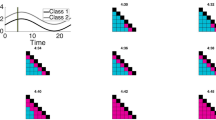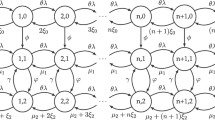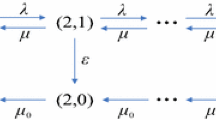Abstract
Motivated by communication networks, we study an admission control problem for a Markovian loss system comprised of two finite capacity service stations in tandem. Customers arrive to station 1 according to a Poisson process, and a gatekeeper, who has complete knowledge of the number of customers at both stations, decides whether to accept or reject each arriving customer. If a customer is rejected, a rejection cost is incurred. If an admitted customer finds that station 2 is full at the time of his service completion at station 1, he leaves the system and a loss cost is incurred. The goal is to find easy-to-implement policies that minimize long-run average cost per unit time. We formulate two intuitive, extremal policies and provide analytical results on their performances. We also present necessary and/or sufficient conditions under which each of these policies is optimal. Next, we show that for some states of the system it is always optimal to admit new arrivals. We also fully characterize the optimal policy when the capacity of each station is two and discuss some characteristics of optimal policies in general. Finally, we design heuristic admission control policies using these insights. Numerical experiments indicate that these heuristic policies yield near-optimal long-run average cost performance.




Similar content being viewed by others
References
Bertsekas, D., Gallager, R.: Data Networks, 2nd edn. Prentice-Hall Inc, Upper Saddle River (1992)
Chang, K.-H., Chen, W.-F.: Admission control policies for two-stage tandem queues with no waiting spaces. Comput. Oper. Res. 30(4), 589–601 (2003)
Cheng, M.C.: New criteria for the simplex algorithm. Math. Program. 19(1), 230–236 (1980)
Cheng, M.C.: Generalized theorems for permanent basic and nonbasic variables. Math. Program. 31(2), 229–234 (1985)
de Nitto Persone, V., Grassi, V.: Solution of finite QBD processes. J. Appl. Probab. 33(4), 1003–1010 (1996)
Ghoneim, H.A., Stidham, S.: Control of arrivals to two queues in series. Eur. J. Oper. Res. 21(3), 399–409 (1985)
Gordon, W.J., Newell, G.F.: Closed queueing systems with exponential servers. Oper. Res. 15(2), 254–265 (1967)
Hordijk, A., Kallenberg, L.C.M.: Linear programming and Markov decision chains. Manag. Sci. 25(4), 352–362 (1979)
Hordijk, A., Koole, G.: On the assignment of customers to parallel queues. Probab. Eng. Inf. Sci. 6(3), 495–511 (1992)
Hordijk, A., Koole, G.: On the shortest queue policy for the tandem parallel queue. Probab. Eng. Inf. Sci. 6, 63–79 (1992)
Kallenberg, L.C.M.: Finite state and action MDPs. In: Handbook of Markov Decision Processes. Springer, pp. 21–87 (2002)
Kim, B., Kim, J.: Optimal admission control for two station tandem queues with loss. Oper. Res. Lett. 42(4), 257–262 (2014)
Kim, B., Kim, J.: Equilibrium strategies for a tandem network under partial information. Oper. Res. Lett. 44(4), 532–534 (2016)
Kim, C., Dudin, S.: Priority tandem queueing model with admission control. Comput. Ind. Eng. 61(1), 131–140 (2011)
Ku, C.-Y., Jordan, S.: Access control to two multiserver loss queues in series. IEEE Trans. Autom. Control 42(7), 1017–1023 (1997)
Ku, C.-Y., Jordan, S.: Access control of parallel multiserver loss queues. Perform. Eval. 50(4), 219–231 (2002)
Ku, C.-Y., Jordan, S.: Near optimal admission control for multiserver loss queues in series. Eur. J. Oper. Res. 144(1), 166–178 (2003)
Latouche, G., Ramaswami, V.: Introduction to Matrix Analytic Methods in Stochastic Modeling, vol. 5. Siam, University City (1999)
Leskelä, L., Resing, J.: A tandem queueing network with feedback admission control. In: Network Control and Optimization. Springer, pp. 129–137 (2007)
Li, A.A., Whitt, W.: Approximate blocking probabilities in loss models with independence and distribution assumptions relaxed. Perform. Eval. 80, 82–101 (2014)
Lippman, S.A.: Applying a new device in the optimization of exponential queuing systems. Oper. Res. 23(4), 687–710 (1975)
Litvak, N., van Rijsbergen, M., Boucherie, R.J., van Houdenhoven, M.: Managing the overflow of intensive care patients. Eur. J. Oper. Res. 185(3), 998–1010 (2008)
Paparrizos, K., Stephanides, G., Samaras, N.: Improved criteria for identifying optimal basic and nonbasic variables in LP. J. Comput. Anal. Appl. 3(1), 75–82 (2001)
Puterman, M.L.: Markov Decision Processes: Discrete Stochastic Dynamic Programming. Wiley-Interscience, Hoboken (1994)
Sheu, R.-S., Ziedins, I.: Asymptotically optimal control of parallel tandem queues with loss. Queueing Syst. 65(3), 211–227 (2010)
Shi, Y., Yu, P.-L., Zhang, D.: Eliminating permanently dominated opportunities in multiple-criteria and multiple-constraint level linear programming. J. Math. Anal. Appl. 183(3), 685–705 (1994)
Silva, D.F., Zhang, B., Ayhan, H.: Optimal admission control for tandem loss systems with two stations. Oper. Res. Lett. 41(4), 351–356 (2013)
Spicer, S., Ziedins, I.: User-optimal state-dependent routeing in parallel tandem queues with loss. J. Appl. Probab. 43, 274–281 (2006)
Stidham Jr., S., Weber, R.: A survey of Markov decision models for control of networks of queues. Queueing Syst. 13(1–3), 291–314 (1993)
Ye, Y.: Eliminating columns in the simplex method for linear programming. J. Optim. Theory Appl. 63(1), 69–77 (1989)
Zhang, B., Ayhan, H.: Optimal admission control for tandem queues with loss. IEEE Trans. Autom. Control 58(1), 163–167 (2013)
Zhang, R., Phillis, Y.A.: Fuzzy control of arrivals to tandem queues with two stations. IEEE Trans. Fuzzy Syst. 7(3), 361–367 (1999)
Ziedins, I.: A paradox in a queueing network with state-dependent routing and loss. Adv. Decis. Sci. 2007, (Article ID 68280), (2007)
Author information
Authors and Affiliations
Corresponding author
Rights and permissions
About this article
Cite this article
Silva, D.F., Zhang, B. & Ayhan, H. Admission control strategies for tandem Markovian loss systems. Queueing Syst 90, 35–63 (2018). https://doi.org/10.1007/s11134-017-9569-3
Received:
Revised:
Published:
Issue Date:
DOI: https://doi.org/10.1007/s11134-017-9569-3
Keywords
- Admission control
- Loss networks
- Tandem queueing networks
- Markov decision processes
- Quasi-birth-and-death processes
- Linear programming




